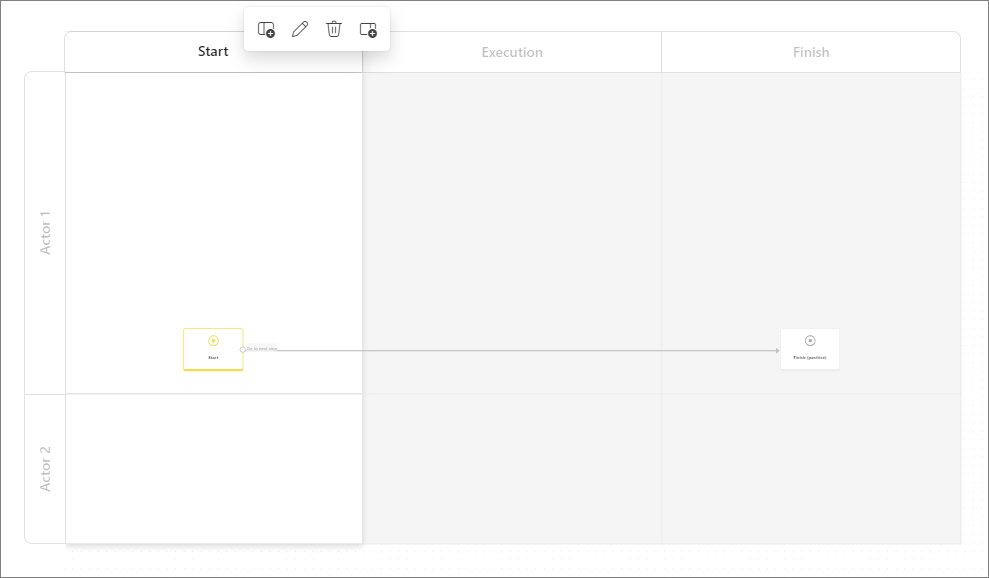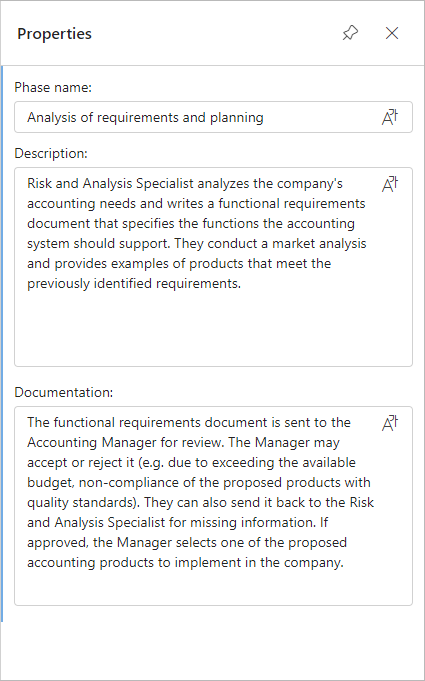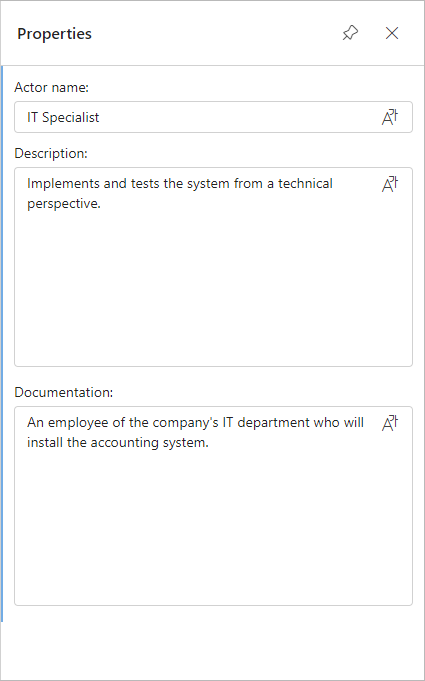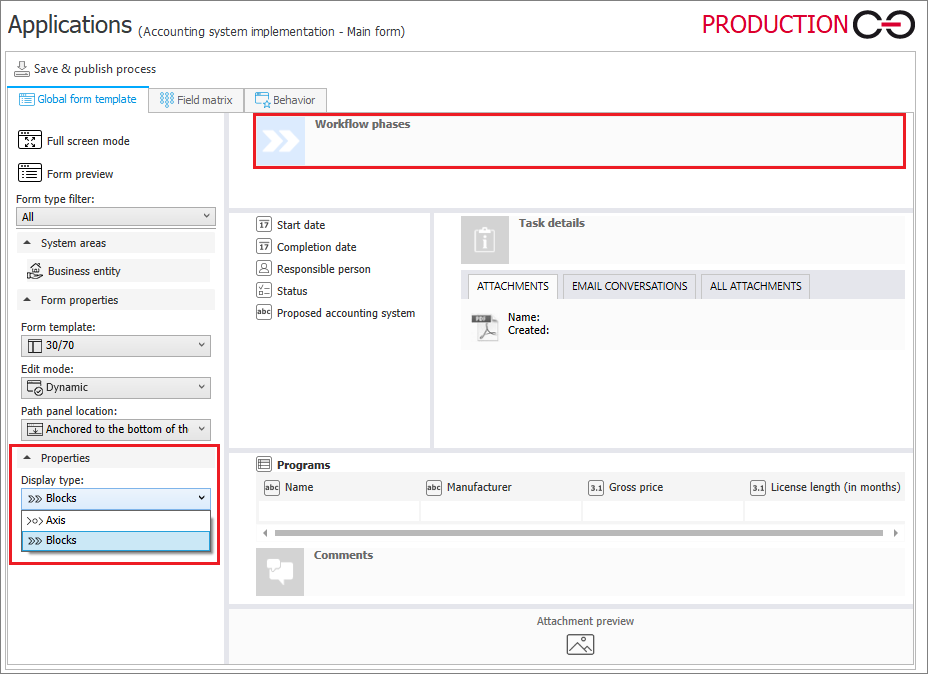Workflow phases and actors
Applies to version 2025 R1 and above, author: Krystyna Gawryał
Related documentation
A detailed description of the functionalities mentioned herein and their configuration can be found in the following sections of the WEBCON BPS Help:
- Workflow designer | WEBCON BPS
- Global form template | WEBCON BPS
- Field matrix | WEBCON BPS
- Form | WEBCON BPS
Introduction
Version 2025 R1 of WEBCON BPS introduced two new functionalities: Workflow phases and Workflow actors, which aim to visually divide the steps and tasks assigned to them according to the stages of execution (phases) and the people responsible for their completion (actors). Together, these functionalities create an additional layer of visualization of the workflow, making it more transparent and easier to understand.
This article describes these functionalities using a sample workflow for the process of implementing a new accounting system.
Business case
The sample workflow for the process of implementing a new accounting system includes 3 phases, 8 steps, and 3 actors. Below is a brief description of the various phases and steps of this workflow, along with their assumptions.
Phase 1: Analysis of requirements and planning
Actors: Risk and Analysis Specialist, Accounting Manager
Step 1 (start): Registration of requirements and creation of specifications
Description: Risk and Analysis Specialist analyzes the company's accounting needs and writes a functional requirements document that specifies the functions the accounting system should support. They conduct a market analysis and provides examples of products that meet the previously identified requirements.
Step 2: Initial review
Description: The functional requirements document is sent to the Accounting Manager for review. The Manager may accept or reject it (e.g. due to exceeding the available budget, non-compliance of the proposed products with quality standards). They can also send it back to the Risk and Analysis Specialist for missing information. If approved, the Manager selects one of the proposed accounting products to implement in the company.
Step 3: Creating an implementation plan
Description: After approving the functional requirements, the Accounting Manager creates an "Implementation plan" that includes the timeline, resources, and budget allocation for the project. The plan also includes training stages for users of the accounting system. The Manager sends the plan and the system implementation order to the IT specialist.
Phase 2: System implementation
Actor: IT Specialist
Step 4: Installation and configuration
Description: The IT specialist implements and configures the accounting system based on the "Implementation plan". On an ongoing basis, the IT Specialist prepares an "Implementation progress report" describing the activities performed and the problems encountered. Appropriate technical documentation (including instructions for installing and using the system, license agreements, etc.) is also added to the workflow.
Step 5: Testing
Description: The IT Specialist tests the accounting system. For example, they check whether all required components are installed, whether the data entered is secure, or whether the program connects to external systems and retrieves data from them correctly. They fill out a form with test results and conclusions. The IT Specialist submits the test report to the Accounting Manager.
Phase 3: Evaluation and deployment
Actor: Accounting Manager
Step 6: Post-implementation review
Description: The Manager reviews the operation of the system and evaluates its compliance with business requirements. They may accept it or, in the event of a non-compliance, decide to return the process to the implementation phase.
Step 7 (final, positive): Acceptance and handover
Description: The Manager has positively assessed the implemented system and supervises its handover to the Accounting Department. At the same time, they have accepted the related documentation, which formally completes the implementation of the accounting system.
Step 8 (final, negative): Rejection
Description: The Manager rejected the system due to unsatisfactory test results, existing errors, detected data security threats, etc. They may also roll back the workflow to the "Initial review" step to select another accounting system that meets the defined functional requirements.
The diagram of the workflow described above may look as follows:

Creating this sample workflow design is possible with the use of functionalities that have appeared, among others, in the new, web-based version of the Workflow designer in WEBCON BPS Designer Studio 2025 R1.
Functional changes of WEBCON BPS
Designer Studio
The Workflow phases and Workflow actors functionalities can be enabled in WEBCON BPS Designer Studio by selecting the appropriate checkboxes in the Workflow settings section of the General tab in the workflow configuration window.

Three default phases appear in the Workflow designer: Start, Execution, and Finish, as well as two actors: Actor 1 and Actor 2. By default, the entire workflow is placed in the Execution phase and/or at the Actor 1 level. In the case of newly created applications, standard processes and their workflows, the Workflow phases functionality is automatically enabled – the start step is assigned to the Start phase, and the final step to the Finish phase. As the workflow expands to include new steps, it is possible to drag them into any phase/actor fields, as well as add and remove phases and actors using the menu available by clicking on their names. A new phase can be added to the left or right of the currently edited phase by selecting one of the dedicated buttons. Similarly, a new actor can be added above or below the currently edited actor.

Selecting the Edit button in this menu (pencil icon) opens the Properties window, where you can change the name, description, and documentation of the phase and their translations.

A similar window is available for actors:

It is also possible to change the size of individual phase/actor blocks directly on the diagram, with a minimum size of 400 px.
Enabling Workflow phases is equivalent to activating the grouping and sorting of steps by defined phases in the Workflow steps section (General tab).
Note: From version 2025 R1, it is no longer possible to add new steps here; this can only be done from the Workflow designer.

Information on defined phases and actors is also provided in dedicated chapters of the documentation generated for a given process.

Form and its configuration
Enabling Workflow phases also makes changes to the Global form template in Designer Studio, where the Workflow phases control appears in the System areas section. Its function on the form is to inform the user which of the defined phases the workflow instance is currently in. Clicking on this control in the configuration window brings up the Properties node, where you can select one of two area Display types: Axis or Blocks. For newly created workflows, the Workflow phases area is automatically added to the top panel of the form.

The division of steps into phases is also visible in the Field matrix. In addition, enabling the functionality determines the content of its Standard areas tab. In this case, the Steps row is replaced by the Phases and steps row.

At the same time, the steps are displayed by phase in the Info panel on the form. (The Workflow phases control, the visibility of which is configured in the Global form template, is also marked in the figure below).

The Steps option in the Area visibility section (Forms tab of the step edit window) is updated in the same way after enabling the Workflow phases.

Designer Desk and Process design
The Workflow phases and Workflow actors functionalities are also available in WEBCON BPS Designer Desk and in the Process design section of Portal.
In Designer Desk, it is possible to enable and disable these functionalities, assign individual steps to them, edit the number, names and descriptions of phases and actors, present information on Workflow phases on the form and in the Field matrix, as well as include data on phases and actors in the generated prototype documentation.

The Process design section in Portal displays the settings of phases and actors entered in WEBCON BPS Designer Studio, and users with relevant privileges can change their metadata (names, descriptions, documentation and translations).

Summary
In addition to the obvious functions of organizing and presenting data, workflow phases and actors can be critical to the effective management, control, and optimization of business processes. They help to precisely determine who is responsible for a given stage, what tasks should be performed, and how documents and information flow through individual departments of the organization. In addition, the introduction of phases and actors makes it possible to better define the scope of responsibilities and the division of work, as well as to manage the risk of errors, which is particularly important for complex tasks and projects.

